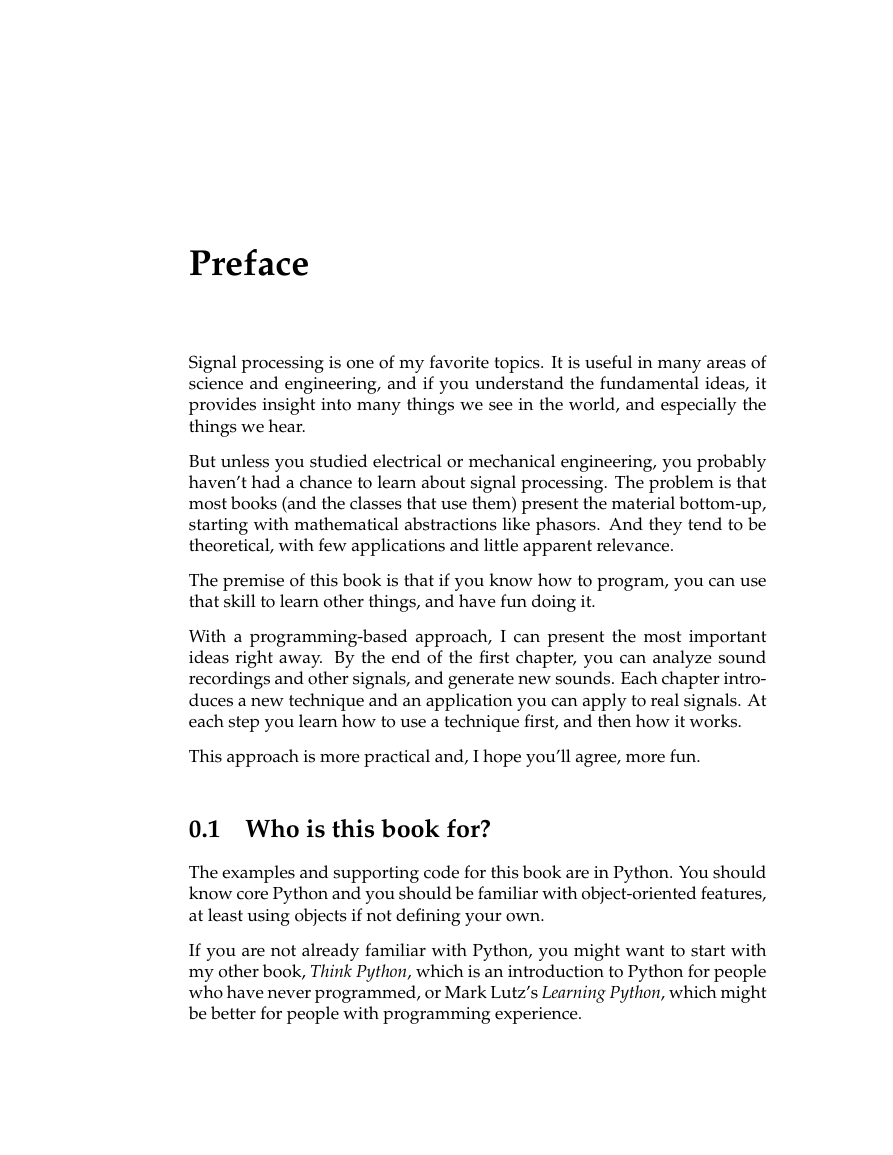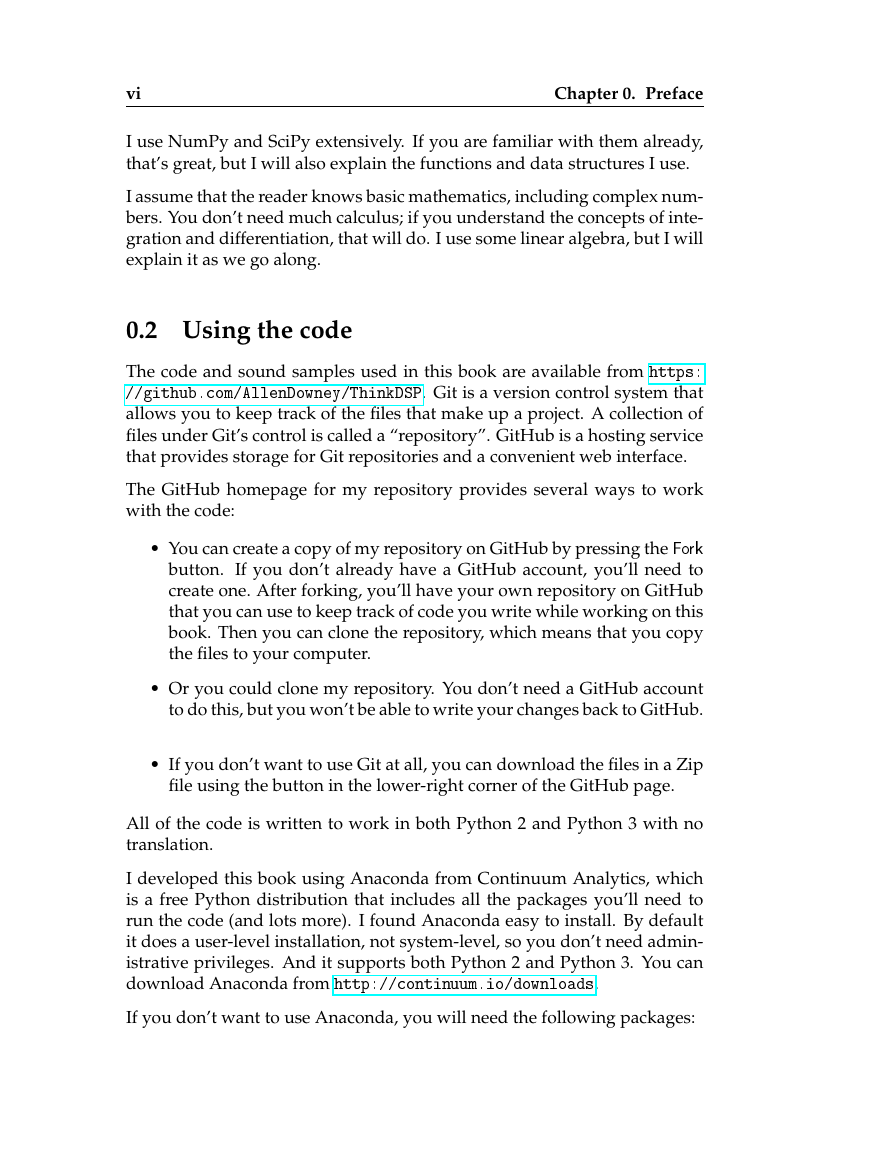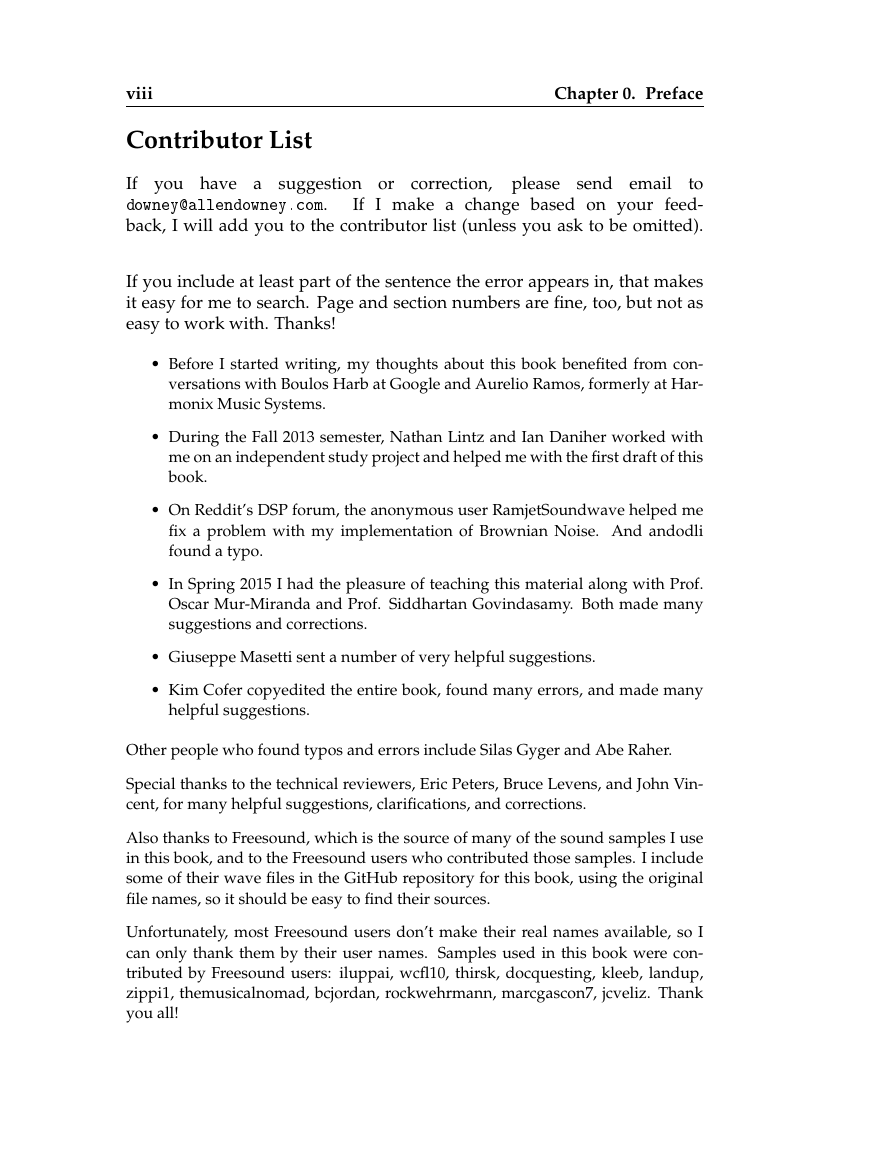Think DSP
Digital Signal Processing in Python
Version 1.0.9
�
�
Think DSP
Digital Signal Processing in Python
Version 1.0.9
Allen B. Downey
Green Tea Press
Needham, Massachusetts
�
Copyright © 2014 Allen B. Downey.
Green Tea Press
9 Washburn Ave
Needham MA 02492
Permission is granted to copy, distribute, and/or modify this document
under the terms of the Creative Commons Attribution-NonCommercial
3.0 Unported License, which is available at http://creativecommons.org/
licenses/by-nc/3.0/.
�
Preface
Signal processing is one of my favorite topics. It is useful in many areas of
science and engineering, and if you understand the fundamental ideas, it
provides insight into many things we see in the world, and especially the
things we hear.
But unless you studied electrical or mechanical engineering, you probably
haven’t had a chance to learn about signal processing. The problem is that
most books (and the classes that use them) present the material bottom-up,
starting with mathematical abstractions like phasors. And they tend to be
theoretical, with few applications and little apparent relevance.
The premise of this book is that if you know how to program, you can use
that skill to learn other things, and have fun doing it.
With a programming-based approach, I can present the most important
ideas right away. By the end of the first chapter, you can analyze sound
recordings and other signals, and generate new sounds. Each chapter intro-
duces a new technique and an application you can apply to real signals. At
each step you learn how to use a technique first, and then how it works.
This approach is more practical and, I hope you’ll agree, more fun.
0.1 Who is this book for?
The examples and supporting code for this book are in Python. You should
know core Python and you should be familiar with object-oriented features,
at least using objects if not defining your own.
If you are not already familiar with Python, you might want to start with
my other book, Think Python, which is an introduction to Python for people
who have never programmed, or Mark Lutz’s Learning Python, which might
be better for people with programming experience.
�
vi
Chapter 0. Preface
I use NumPy and SciPy extensively. If you are familiar with them already,
that’s great, but I will also explain the functions and data structures I use.
I assume that the reader knows basic mathematics, including complex num-
bers. You don’t need much calculus; if you understand the concepts of inte-
gration and differentiation, that will do. I use some linear algebra, but I will
explain it as we go along.
0.2 Using the code
The code and sound samples used in this book are available from https:
//github.com/AllenDowney/ThinkDSP. Git is a version control system that
allows you to keep track of the files that make up a project. A collection of
files under Git’s control is called a “repository”. GitHub is a hosting service
that provides storage for Git repositories and a convenient web interface.
The GitHub homepage for my repository provides several ways to work
with the code:
• You can create a copy of my repository on GitHub by pressing the Fork
button. If you don’t already have a GitHub account, you’ll need to
create one. After forking, you’ll have your own repository on GitHub
that you can use to keep track of code you write while working on this
book. Then you can clone the repository, which means that you copy
the files to your computer.
• Or you could clone my repository. You don’t need a GitHub account
to do this, but you won’t be able to write your changes back to GitHub.
• If you don’t want to use Git at all, you can download the files in a Zip
file using the button in the lower-right corner of the GitHub page.
All of the code is written to work in both Python 2 and Python 3 with no
translation.
I developed this book using Anaconda from Continuum Analytics, which
is a free Python distribution that includes all the packages you’ll need to
run the code (and lots more). I found Anaconda easy to install. By default
it does a user-level installation, not system-level, so you don’t need admin-
istrative privileges. And it supports both Python 2 and Python 3. You can
download Anaconda from http://continuum.io/downloads.
If you don’t want to use Anaconda, you will need the following packages:
�
0.2. Using the code
vii
• NumPy for basic numerical computation, http://www.numpy.org/;
• SciPy for scientific computation, http://www.scipy.org/;
• matplotlib for visualization, http://matplotlib.org/.
Although these are commonly used packages, they are not included with all
Python installations, and they can be hard to install in some environments.
If you have trouble installing them, I recommend using Anaconda or one of
the other Python distributions that include these packages.
Most exercises use Python scripts, but some also use Jupyter notebooks. If
you have not used Jupyter before, you can read about it at http://jupyter.
org.
There are three ways you can work with the Jupyter notebooks:
Run Jupyter on your computer If you installed Anaconda, you probably
got Jupyter by default. To check, start the server from the command
line, like this:
$ jupyter notebook
If it’s not installed, you can install it in Anaconda like this
$ conda install jupyter
When you start the server, it should launch your default web browser
or create a new tab in an open browser window.
Run Jupyter on Binder Binder is a service that runs Jupyter in a vir-
tual machine.
If you follow this link, http://mybinder.org/repo/
AllenDowney/ThinkDSP, you should get a Jupyter home page with the
notebooks for this book and the supporting data and scripts.
You can run the scripts and modify them to run your own code, but
the virtual machine you run in is temporary. Any changes you make
will disappear, along with the virtual machine, if you leave it idle for
more than about an hour.
View notebooks on nbviewer When we refer to notebooks later in the
book, we provide links to nbviewer, which provides a static view of
the code and results. You can use these links to read the notebooks
and listen to the examples, but you won’t be able to modify or run the
code, or use the interactive widgets.
Good luck, and have fun!
�
viii
Contributor List
Chapter 0. Preface
to
If you have a suggestion or
downey@allendowney.com.
If I make a change based on your feed-
back, I will add you to the contributor list (unless you ask to be omitted).
correction, please send email
If you include at least part of the sentence the error appears in, that makes
it easy for me to search. Page and section numbers are fine, too, but not as
easy to work with. Thanks!
• Before I started writing, my thoughts about this book benefited from con-
versations with Boulos Harb at Google and Aurelio Ramos, formerly at Har-
monix Music Systems.
• During the Fall 2013 semester, Nathan Lintz and Ian Daniher worked with
me on an independent study project and helped me with the first draft of this
book.
• On Reddit’s DSP forum, the anonymous user RamjetSoundwave helped me
fix a problem with my implementation of Brownian Noise. And andodli
found a typo.
• In Spring 2015 I had the pleasure of teaching this material along with Prof.
Oscar Mur-Miranda and Prof. Siddhartan Govindasamy. Both made many
suggestions and corrections.
• Giuseppe Masetti sent a number of very helpful suggestions.
• Kim Cofer copyedited the entire book, found many errors, and made many
helpful suggestions.
Other people who found typos and errors include Silas Gyger and Abe Raher.
Special thanks to the technical reviewers, Eric Peters, Bruce Levens, and John Vin-
cent, for many helpful suggestions, clarifications, and corrections.
Also thanks to Freesound, which is the source of many of the sound samples I use
in this book, and to the Freesound users who contributed those samples. I include
some of their wave files in the GitHub repository for this book, using the original
file names, so it should be easy to find their sources.
Unfortunately, most Freesound users don’t make their real names available, so I
can only thank them by their user names. Samples used in this book were con-
tributed by Freesound users: iluppai, wcfl10, thirsk, docquesting, kleeb, landup,
zippi1, themusicalnomad, bcjordan, rockwehrmann, marcgascon7, jcveliz. Thank
you all!
�
















 2023年江西萍乡中考道德与法治真题及答案.doc
2023年江西萍乡中考道德与法治真题及答案.doc 2012年重庆南川中考生物真题及答案.doc
2012年重庆南川中考生物真题及答案.doc 2013年江西师范大学地理学综合及文艺理论基础考研真题.doc
2013年江西师范大学地理学综合及文艺理论基础考研真题.doc 2020年四川甘孜小升初语文真题及答案I卷.doc
2020年四川甘孜小升初语文真题及答案I卷.doc 2020年注册岩土工程师专业基础考试真题及答案.doc
2020年注册岩土工程师专业基础考试真题及答案.doc 2023-2024学年福建省厦门市九年级上学期数学月考试题及答案.doc
2023-2024学年福建省厦门市九年级上学期数学月考试题及答案.doc 2021-2022学年辽宁省沈阳市大东区九年级上学期语文期末试题及答案.doc
2021-2022学年辽宁省沈阳市大东区九年级上学期语文期末试题及答案.doc 2022-2023学年北京东城区初三第一学期物理期末试卷及答案.doc
2022-2023学年北京东城区初三第一学期物理期末试卷及答案.doc 2018上半年江西教师资格初中地理学科知识与教学能力真题及答案.doc
2018上半年江西教师资格初中地理学科知识与教学能力真题及答案.doc 2012年河北国家公务员申论考试真题及答案-省级.doc
2012年河北国家公务员申论考试真题及答案-省级.doc 2020-2021学年江苏省扬州市江都区邵樊片九年级上学期数学第一次质量检测试题及答案.doc
2020-2021学年江苏省扬州市江都区邵樊片九年级上学期数学第一次质量检测试题及答案.doc 2022下半年黑龙江教师资格证中学综合素质真题及答案.doc
2022下半年黑龙江教师资格证中学综合素质真题及答案.doc